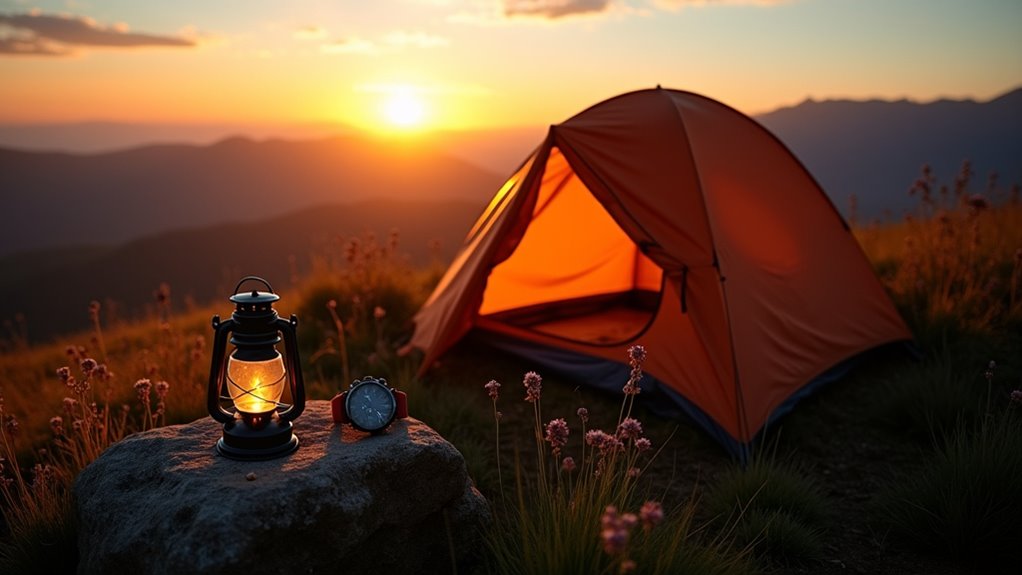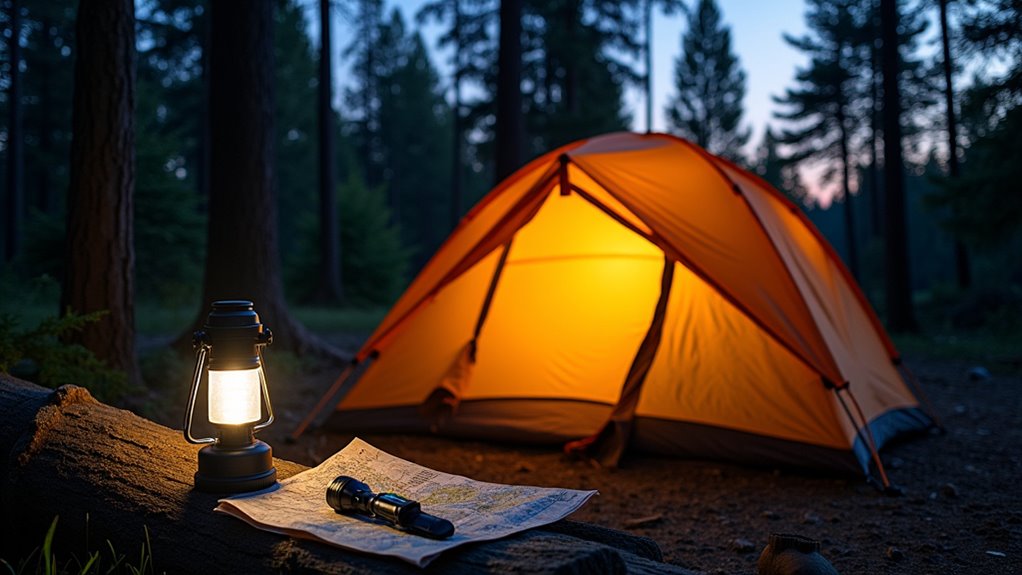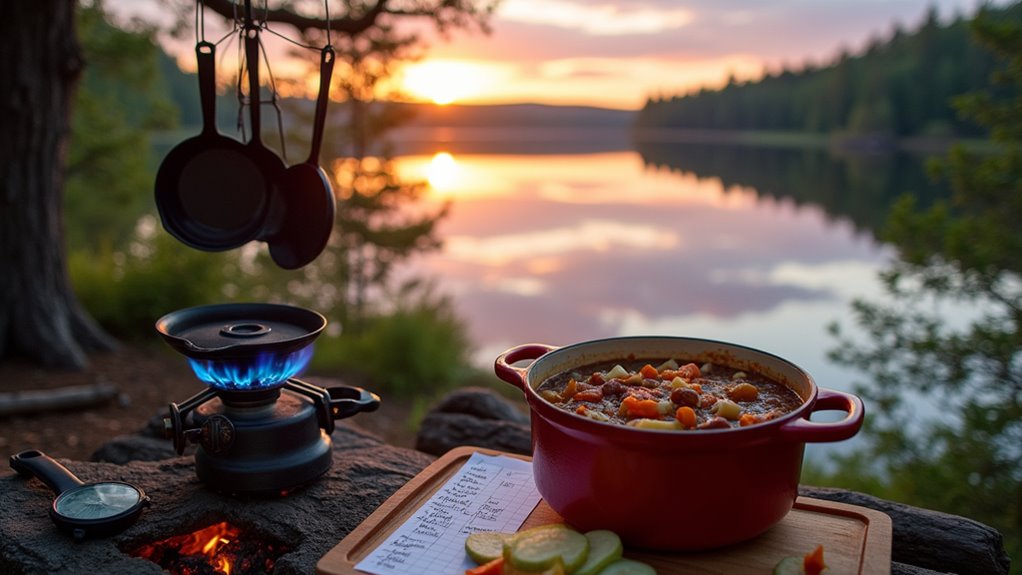Physical Address
304 North Cardinal St.
Dorchester Center, MA 02124
Physical Address
304 North Cardinal St.
Dorchester Center, MA 02124

Building the perfect wild camping schedule unlocks freedom in nature, but only if you know these crucial timing secrets.
Like a well-oiled machine, your wild camping schedule can mean the difference between a serene outdoor experience and a chaotic struggle against time and nature. You’ll find that mastering the rhythm of dawn-to-dusk activities isn’t just about following a rigid timeline—it’s about adapting to natural patterns while maintaining essential routines. Whether you’re a weekend warrior or planning an extended backcountry stay, understanding how to structure your daily camp schedule will transform your outdoor adventures from merely surviving to truly thriving.

Three key elements define a successful wild camping routine: thorough preparation, consistent daily practices, and adaptability to changing conditions.
To establish an effective schedule, start by evaluating your camping location and checking weather forecasts to plan appropriate activities and safety measures. Consider bringing a lightweight bivvy bag as backup shelter for emergencies. Pack essential camping gear to ensure your comfort and safety.
Planning your wild camping adventure starts with location research and weather monitoring – the foundation of a safe outdoor experience.
Your daily routine should begin with basic hygiene and a simple breakfast like porridge with fruits. Pack clothing in separate dry bags and maintain your tent’s stability throughout your stay.
During the day, use reliable navigation tools while exploring, but always schedule rest periods to prevent exhaustion. As evening approaches, prepare nutritious meals and secure your valuables inside the tent.
Remember to adapt your schedule based on terrain, weather, and daylight hours. Keep emergency procedures in mind and maintain awareness of your surroundings while following leave-no-trace principles.
A successful wild camping timeline revolves around strategic timing and thoughtful execution of essential activities. You should aim to arrive at dusk to minimize your visibility, quickly setting up camp in a pre-scouted location on elevated, durable ground.
Complete your food preparation and eating before darkness falls, then secure all food away from your sleeping area. Keep your evening activities quiet and efficient, using minimal lighting to preserve night vision. If fires are permitted, make certain they’re fully extinguished before sleep. Consider packing high energy snacks to maintain stamina throughout your camping experience. Select the right camping gear is crucial for a successful first-time adventure.
At dawn, start your day early with a simple breakfast and methodical packing. Take extra care to inspect your site for belongings and waste.
When departing, choose a different path to minimize environmental impact, and leave your campsite as undisturbed as possible.

Making efficient use of daylight hours while wild camping can greatly enhance your outdoor experience and safety. You should aim to start your day early, tackling essential tasks like water collection and food preparation during peak daylight.
Rise with the sun and maximize daylight hours for essential camp tasks to ensure both safety and enjoyment outdoors.
Schedule physically demanding activities like hiking and firewood gathering for mid-day when visibility is best. Taking advantage of the park’s Day Use hours from 7 a.m. until sunset ensures you maximize your outdoor activities safely.
Plan your navigation carefully by hitting the trails shortly after sunrise, using natural landmarks for orientation. You must return to camp well before sunset to guarantee proper setup time. Packing a headlamp can help extend your activities into the evening.
During bright hours, charge your solar devices, dry wet gear, and conduct thorough safety checks of your equipment. Don’t forget to store food securely and inspect your campsite for potential hazards.
Remember to perform waste management and fire preparation tasks while you still have good visibility.
Successful wild camping begins with a well-planned setup timeline that maximizes daylight and efficiency.
Start by arriving at your chosen location at least 3 hours before sunset. Spend your first 30 minutes scouting the perfect spot that’s both private and naturally sheltered, while guaranteeing you’re near a water source. Essential camping tips can help ensure you select the best site.
Dedicate the next hour to preparing your site: clear debris, check for hazards, and level the ground where you’ll pitch your tent. Always ensure you have Google satellite imagery readily available on your phone to confirm your exact location.
Set up your tent within 30 minutes, positioning it away from prevailing winds. If campfires are permitted, use the following 30 minutes to build and prepare your fire pit.
Use your final hour before dusk to organize gear, collect water, and conduct safety checks. This timeline guarantees you’re fully set up before darkness falls.

Once darkness falls, your wild camping experience shifts to a critical phase of security and rest management.
When night descends in the wilderness, security becomes paramount as you navigate the delicate balance between vigilance and rest.
You’ll need to implement key protocols to guarantee both safety and quality sleep. Start by setting up blackout curtains in your shelter and concealing any valuables from view. Use dim or red lights to maintain your night vision while moving around camp. Always ensure you can access the driver’s seat from your sleeping area in case of emergency.
Keep noise to a minimum and establish quiet hours for better rest. If you’re camping in wildlife areas, keep deterrents like pepper spray within reach. Familiarize yourself with local wildlife and their behaviors to better anticipate potential encounters.
Consider rotating watch duties with companions for added security. While you don’t need expensive gear, essential items include earplugs, a basic first aid kit, and emergency contact devices.
Remember to stay alert to your surroundings and follow your pre-established emergency protocols if needed.
While maintaining camp security after dark is essential, your daily schedule must remain flexible to accommodate nature’s most unpredictable element: weather.
You’ll need to check forecasts from multiple sources before departure and monitor conditions throughout your trip using weather radios or reliable apps. The scarcity of backcountry weather stations means forecasts may be less accurate for remote areas. Essential tips for enjoying winter camping adventures can help you prepare for unpredictable conditions.
Start each day by evaluating weather risks and adjusting your itinerary accordingly. If afternoon thunderstorms are likely, plan challenging hikes for early morning and seek sheltered areas by midday.
Watch for warning signs like sudden wind shifts or unusual cloud formations. You’ll want to track sunset times to guarantee you’re in a safe location before dark, and always have backup routes planned for severe weather.
Don’t hesitate to modify or cut short activities if conditions become unsafe – it’s better to be cautious than caught unprepared.

Planning meals and cooking times strategically can make or break your wild camping experience. You should focus your main cooking during early evening hours when daylight and warmth are still available.
Start your breakfast prep shortly after waking, and stick to cold or pre-prepared foods for lunch to save time and energy.
Choose lightweight, high-calorie foods that cook quickly, like couscous, instant rice, or dehydrated meals. Pack versatile staples and combine them with simple proteins such as tinned fish or lentils. Consider bringing extra food since increased calorie burn occurs during backpacking activities. Mastering camp cooking in your outdoor kitchen can help ensure you have satisfying meals.
You’ll need nutrient-dense snacks like dried fruits and nuts to maintain energy between meals.
Keep your cooking setup minimal but effective – a reliable portable stove and basic utensils will handle most meals.
One-pot recipes aren’t just convenient; they’ll also minimize cleanup time and environmental impact.
An efficient morning departure starts with a systematic approach to breaking camp. You should aim to wake up early and follow a category-based packing system to streamline the process.
Start by organizing your gear into groups like cooking equipment, sleeping gear, and personal items while using compression bags to save space. Keep your dry sack close by to protect essential gear from morning dew or unexpected rain. Always check the weather forecast before heading out to ensure you’re prepared for the day’s conditions.
Don’t forget the essential environmental responsibilities. Use your pocket trowel to properly dispose of waste, pack out all trash, and restore your campsite to its natural state.
Confirm you’re following local regulations and Leave No Trace principles. Before heading out, conduct a final safety check of your surroundings and verify your navigation tools are ready.
If you’re camping with others, divide tasks to speed up the breakdown process and maintain clear communication about departure timing.
When you’re wild camping, time is of the essence. You’ll save money and stay safer by sticking to a well-planned schedule that works with nature’s rhythm. From sunrise activities to sunset routines, every minute counts. Don’t cut corners on your daily planning – it’s better to be safe than sorry. With consistent timing and weather-smart adjustments, you’ll master the art of efficient wilderness camping.